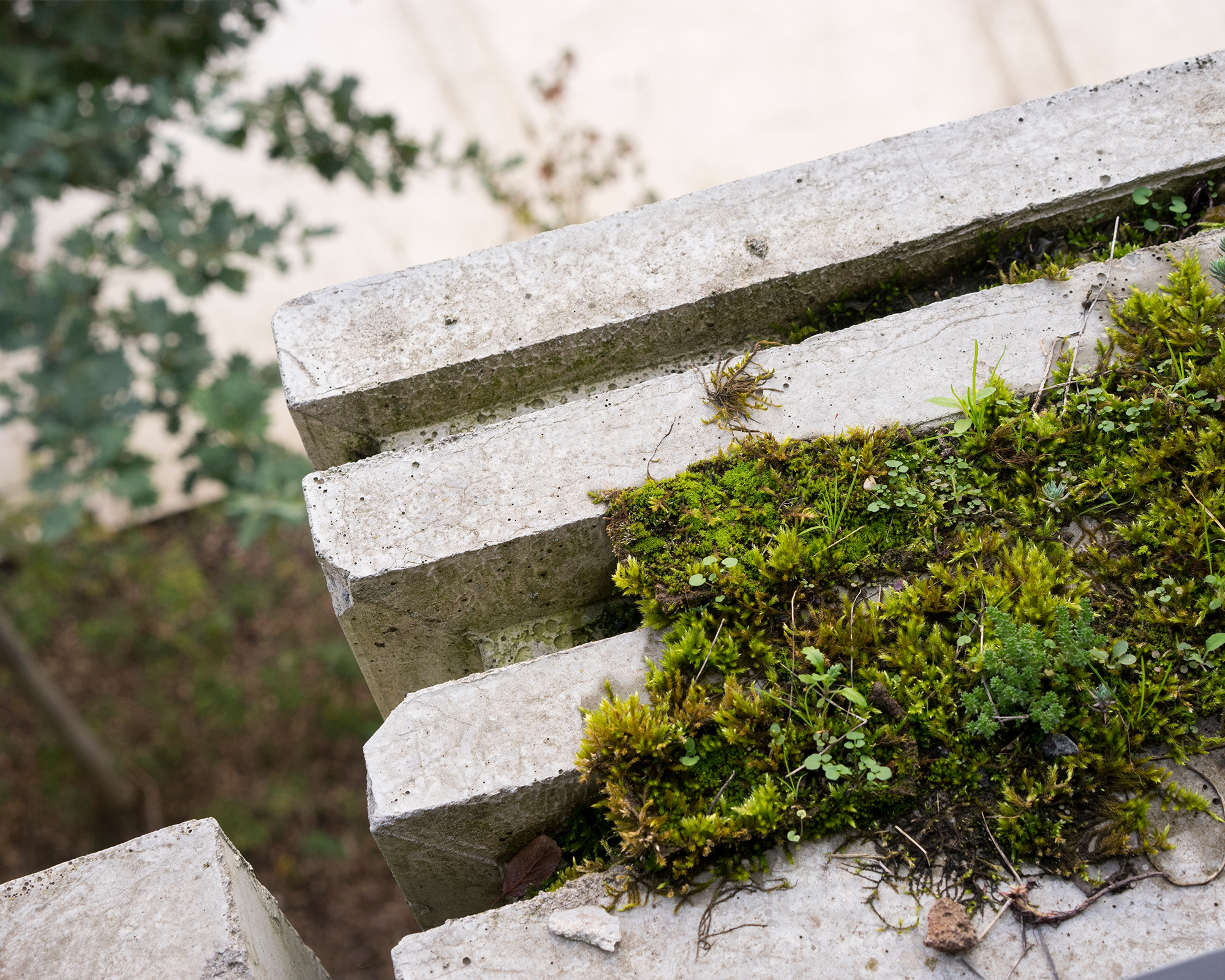
We met Aurélien Huguet at the very beginning of the school project in Boulogne. Biodiversita, the office of applied ecology he founded along with Florent Yvert, had set up a programme of green roof and inhabited wall. We answered to these prescriptions by developing the concrete block wall and its very singular geometry. Through numerous exchanges, we defined together the reception capabilities of the green wall and roof, regarding the fauna and flora.
ChartierDalix: Throughout the reflections we develop about the buildings’ envelopes and the way they operate, we like to use the term ‘exchange surface’. The wall in Boulogne was designed as an exchange surface, between up and down, in its depth, and in its participation to the creation of a milieu.
Aurélien Huguet: Yes, we could compare this to the bowel’s microvilli: we increase significantly the possible exchange surfaces… and speaking of environment, the effectiveness of your wall lays in its ability to multiply the geometrical conditions (chaos, ledges, accidents), multiply the potential for colonisation (thanks to the blocks developing on the whole façade, which increase the range of usable habitat), vary the angles of the blocks, and therefore of the nest boxes, on a single façade, provide rough surfaces to gather fallen material from the roof, settle a water network through these surfaces (grooving and flutes), provide a depth gradient and buffer zones (thanks to the overlapping blocks and embedded zones) in order to widen the scope of possibilities.
We create the necessary conditions for a typical old-wall vegetal colonisation. To achieve this result, we will have to wait for ‘micro-grounds’ to form (this might take 5, 10, 20 years). The formation of these ‘micro-grounds’, necessary to old-wall vegetation, takes place over time. It is a matter of earth, dust, and micro particles accumulation, spread via birds or wind. This basic ‘matrix’ enables the colonisation. Eventually, a living environment specifically adapted to these extreme conditions shall set up.
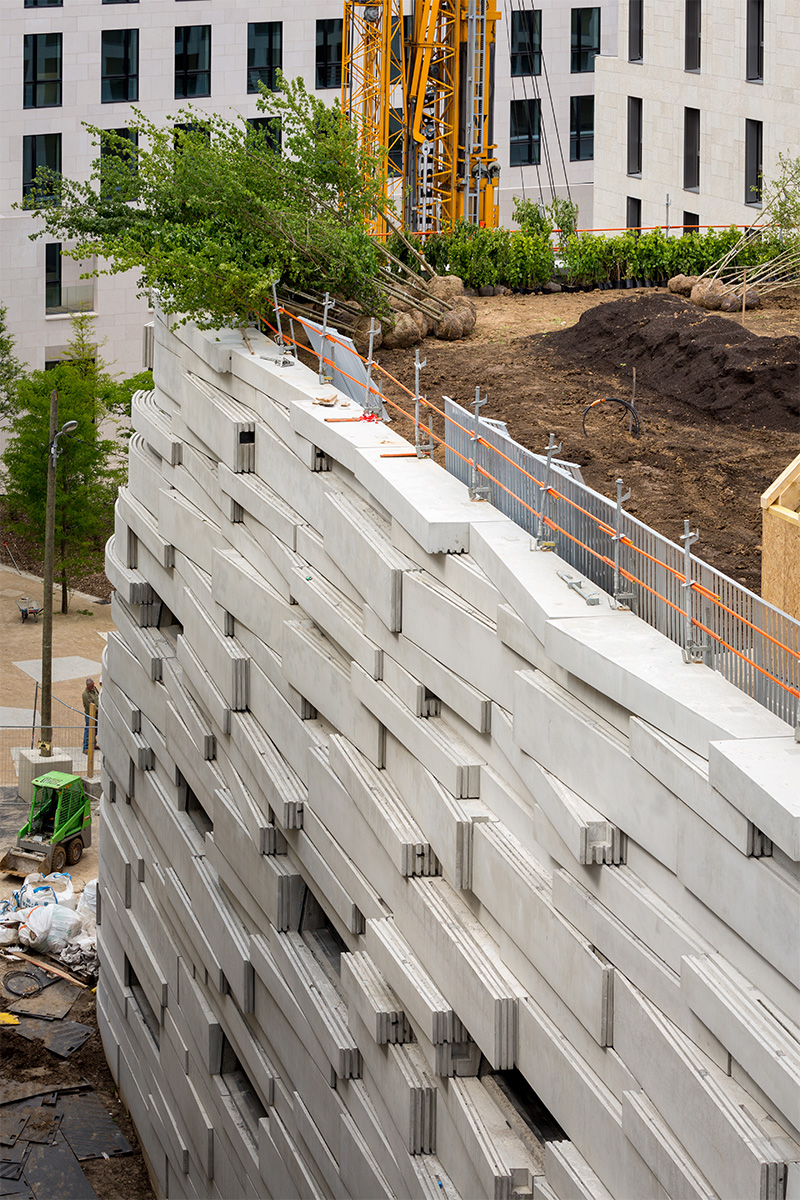
CD: When working together, we dealt with the questions of depth and overlay of elements to favour a cryptic biodiversity.
AH: Cryptic means invisible, hidden. It is all that one cannot see with the naked eye, but which will make everything possible. Having designed the thickness of the blocks and not only their outside surface will enable the development of micro-environments much different from those on the exterior of the wall: first because of the thickness of these ‘micro-grounds’ building up with time (there are much more types of possible grounds in-between the blocks than in the outside crannies, and therefore, different potential species may be found), and second, because it creates buffer zones less exposed to stress and atmospheric conditions. Being deeper, these provide much more stable conditions than the surface of the blocks, a difference akin to that between topsoil and deep soil –but at a much finer scale, that of the ‘micro-ground’ and ‘micro-environment’. The first major spontaneous colonisations will certainly take place in these areas.
CD: Today we realize that the ‘inhabited wall’ is beginning to really operate as such, in terms of hosting the fauna: just the other day, we watched together a titmouse flying out of a block on the south façade, above the gymnasium’s entrance…
AH: This is a good sign! It will lead the way to others! We worked block by block on the nest boxes’ implantation, so as to consider every possible situation. We multiplied the orientations and angles, diversified the altimetry, but also defined the boxes’ positions and volumes as well as the different sizes and the exits’ lay out, according to each targeted species. This titmouse settled in a nest box intended for it. This system also provides overhangs and ledges, which are perfect for swallows. Maybe we will be able to observe common pipistrelles or plecotus hunting in the Trapèze Park or along the Seine and flying around here. I initially asked for cracks and fissures in the materials of the building’s façade, but you offered a system introducing the notion of ‘interstice’ in its very composition and construction: the blocks’ assembly allowed to expand the fissure principle, and above all, to make them more numerous and diversified.
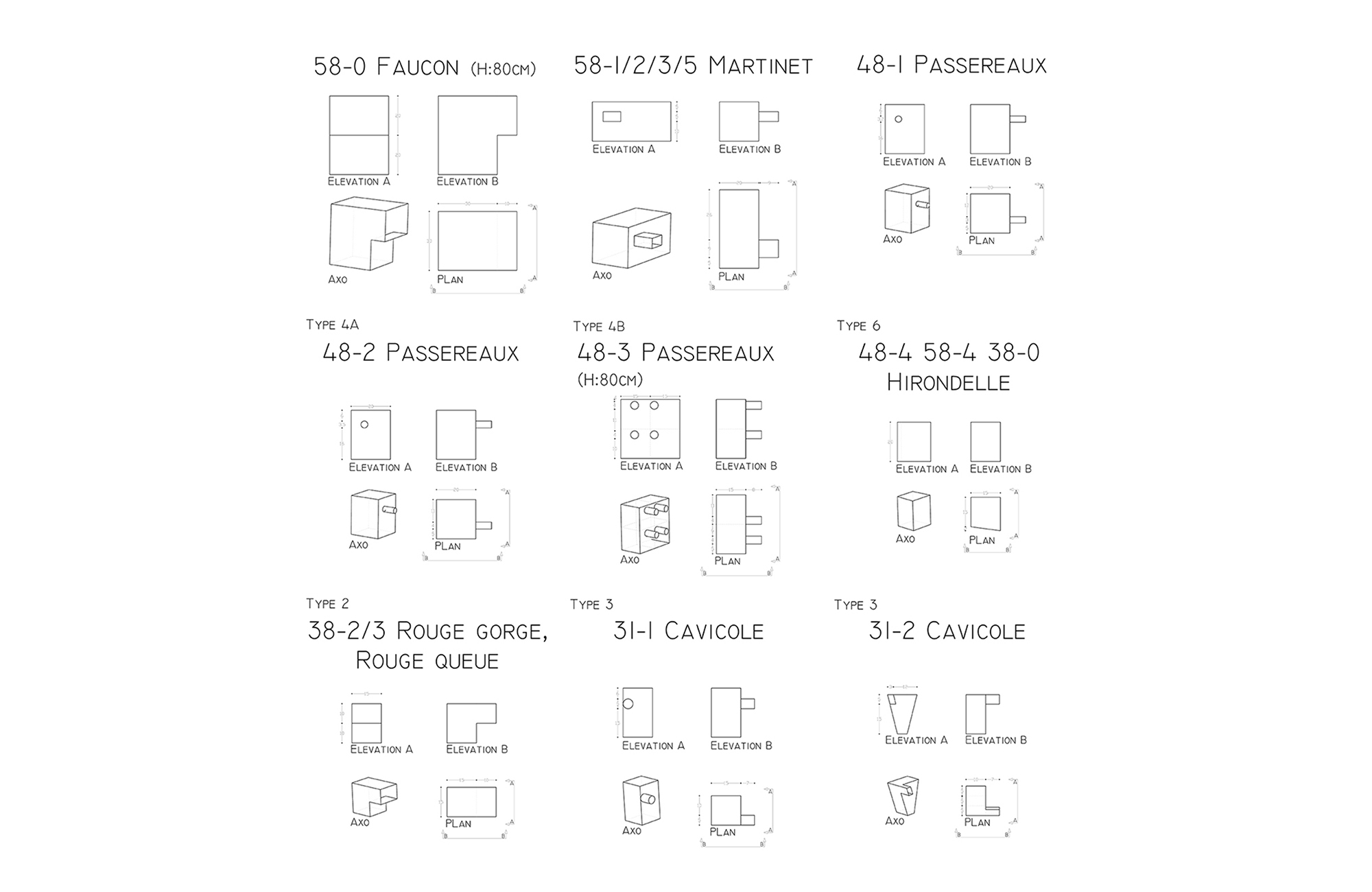
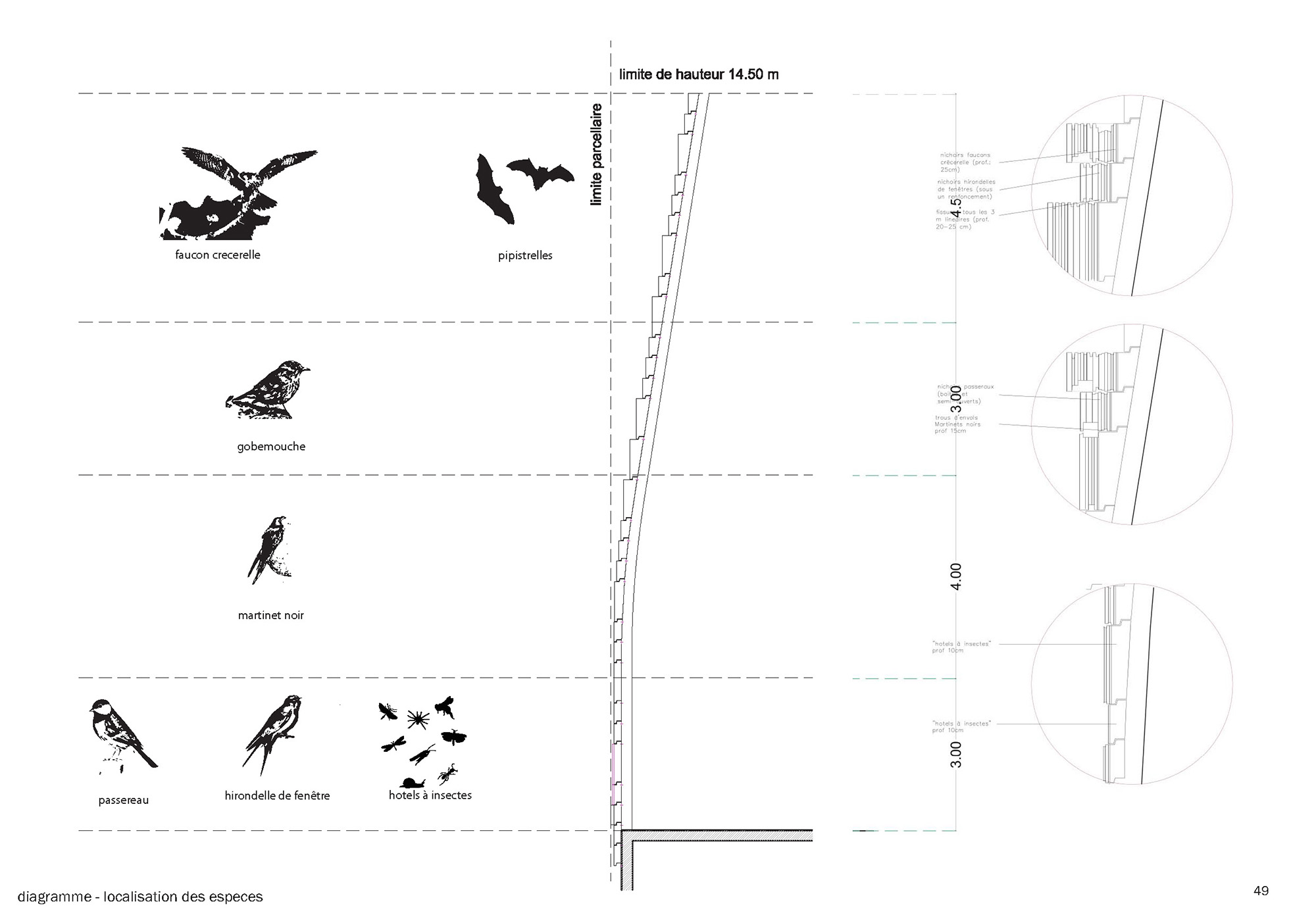
CD: You refer to the individual design of each block, but we ultimately got to work with prefabricated elements, integrated to an industrial manufacturing scheme and rhythm.
AH: The nest boxes lay out was designed ‘by hand’, but you managed to make it possible in terms of cost and construction. It is all the more interesting because the whole approach then becomes feasible: we will see the evolution over time, but if it works, this will become an exportable solution.
CD: Do you believe that regarding this type of experiment on ‘colonisable’ walls, the use of concrete is relevant?
AH: I think it is, as it enables to create interstices, to receive the flora, and to ultimately acquire the ‘old-wall characteristics’. Concrete has got the ability to keep stable properties over time. Its surface erodes like stone, which allows to receive vegetation after a long maturation… We targeted animal and vegetal species which will settle in the crannies, and which are therefore adapted to this material.
CD: The colonisation process begins with the apparition of algae, moss and green stains. The concrete blocks are currently turning green and getting dirty, especially on the northern and western façades. It turns out to be hard for the public to accept the fact that the building ages, ‘micro-deteriorates’, appears dirty, unmaintained…
AH: This is fine, this is the first stage… It is necessary to inform the public by explaining that this is no degradation, but a maturation. The building’s skin is maturing, and will reach maturity through this transformation and colonisation by living organisms.
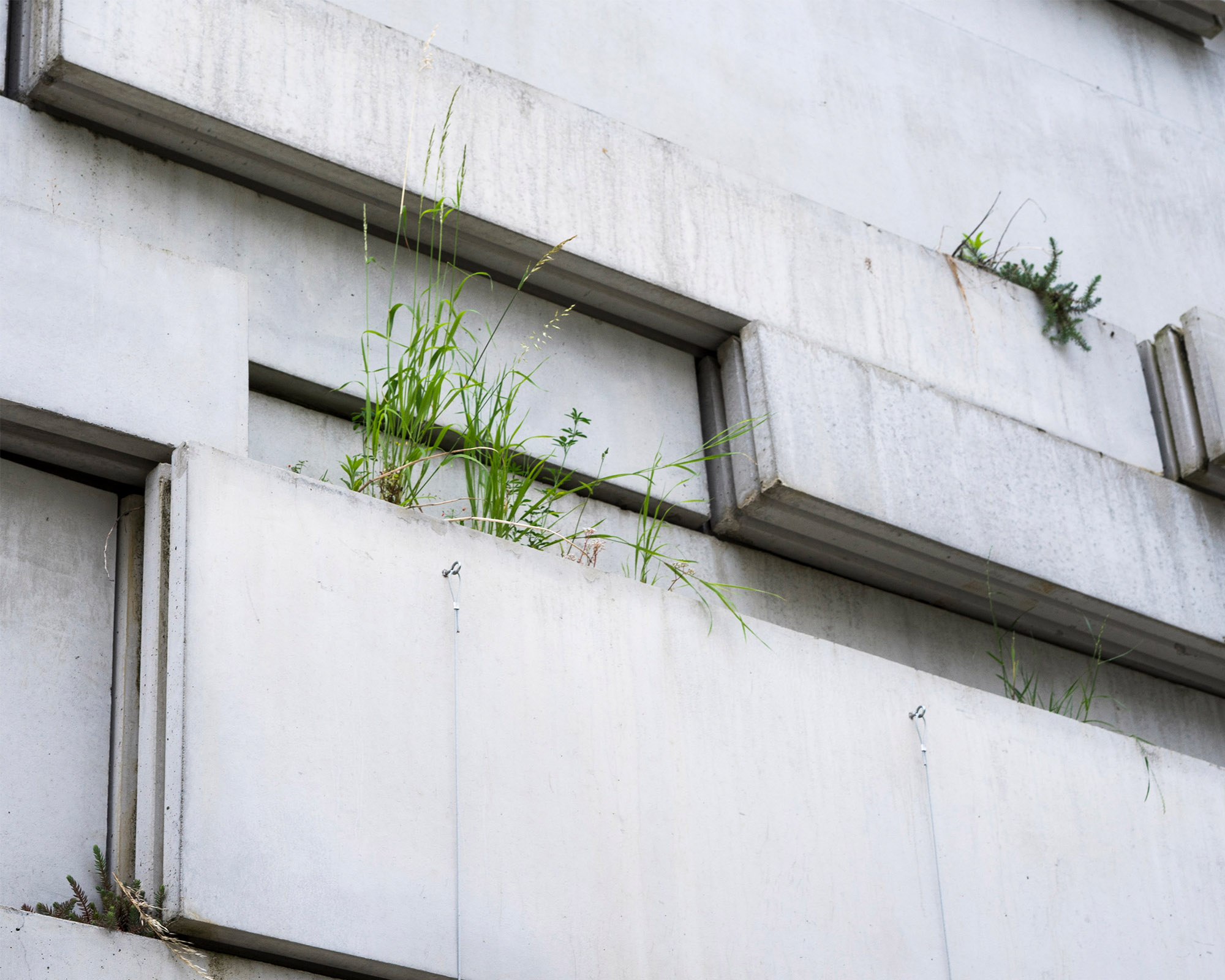
CD: The wall needs time, whereas the roof very quickly became the wooded massif we hoped for. With more than 1m of topsoil, this already is an actual high forest. The smaller topsoil thickness below the forest edge (the ‘hem’) and below the meadow (50cm) allows to keep the desired balance, the stratification. It appears that such an off-ground composition does not have any equivalent so far, in the existing constructions.
AH: We have only tested this composition in open ground yet. This is one of our typical regional compositions: the forest edge. This passage between forest and meadow is frequently composed of recolonising shrubland. One of the issues was to create edges: the ecotones. In other words, transition areas between different environments, where most of the exchanges take place. These are usually the most valuable areas. This is what we reproduced on the roof: a hem between a meadow area and a forest. The forest edge is created by the association of these three layers and by this gradient upward movement from low vegetation to wooded area.
CD: When the building was delivered we were all rather surprised by the surrounding density. May this be a problem, regarding colonisation? Is a ‘wild’ environment compatible with all these buildings, only six metres away from the school?
AH: It is possible for an environment to develop into this density… To make things easier, we must link as many habitats as possible. When it comes to ecological continuity, we are dealing with two different types. The physical continuity is almost impossible to maintain in a dense city. We try to preserve it in ‘peri-urban’ zones through the protection of key areas, blue-green infrastructures, buffer strips and wildlife corridors… But in our situation, we are dealing with ‘stepping stones’ between separate environments including the Seine, the Trapèze Park, and a bit further, Clamart, Meudon, Viroflay… The idea is to create a possible stop. An oasis in the desert. In an almost sterile urban context, we create a place which turns out to be welcoming. This site is hard to colonise, of course, but once the process has started it becomes all the more precious.
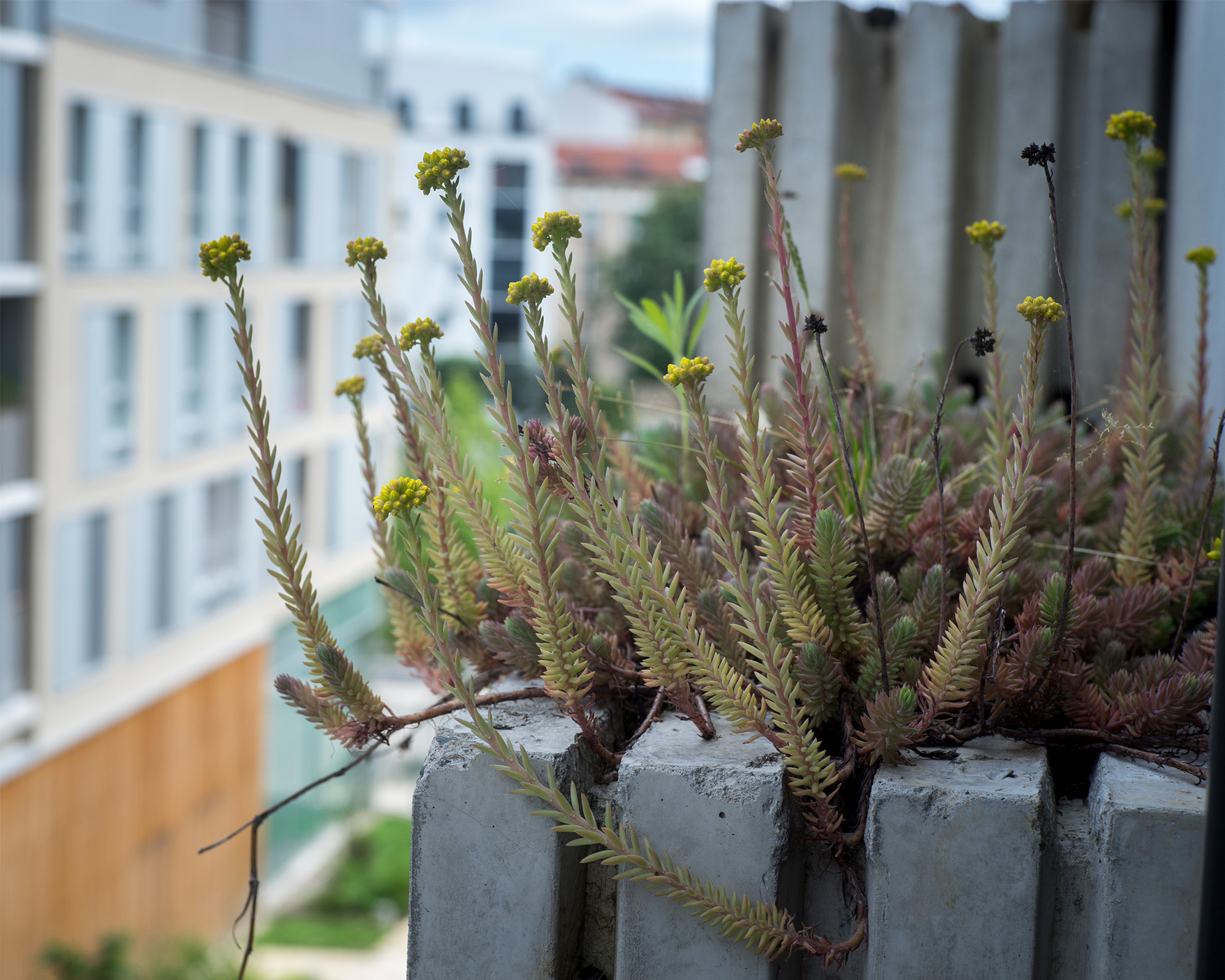
CD: So you do not consider the urban density as an obstacle to the presence of biodiversity?
AH: Let us be clear: it depends on the species. It is an obstacle for terrestrial species. But concerning flying species, the urban density will not preclude colonisation. The real issue is the accessible height. We know that all ground-level species are able to colonise more or less directly up to the fourth floor (butterflies, beetles…). It gets more complicated above this level. A bumblebee cannot forage on the rooftop of a high-rise… The Boulogne school being shaped as a hill, it offers possible communications between the different levels, thanks to the wall and ramps you designed. If we can enable a green path, a continuity between the lower and upper levels, many things may be possible. When aiming to create a colonisable environment, the density isn’t really the issue, but rather the altimetry and the continuity solutions.
CD: The extinction of numerous species since 30 or 40 years is linked to a hostile construction mode towards the implantation of biodiversity. According to you, which would be the requirements to restore favourable conditions?
AH: Knowing that each project requires a specific reflection towards its context, morphology and programme, these are the few points we could list : take the height into account, select native species (in order to favour the survival of ordinary nature against exotic species), work on a precise ground composition (avoid bulk topsoil), define a management method and work along with the managers from the beginning of the conception phase, work on the building’s envelope in order to create thicknesses and crannies, preferring ‘welcoming’ materials : wood makes it easy to design nest boxes, concrete enables to include vegetation… In contrast, metal and glass offer far fewer colonisation opportunities. In any case, dealing with biodiversity, the users’ tolerance is a crucial topic: how far can we tolerate this closeness to nature? This is a cultural and educational issue.
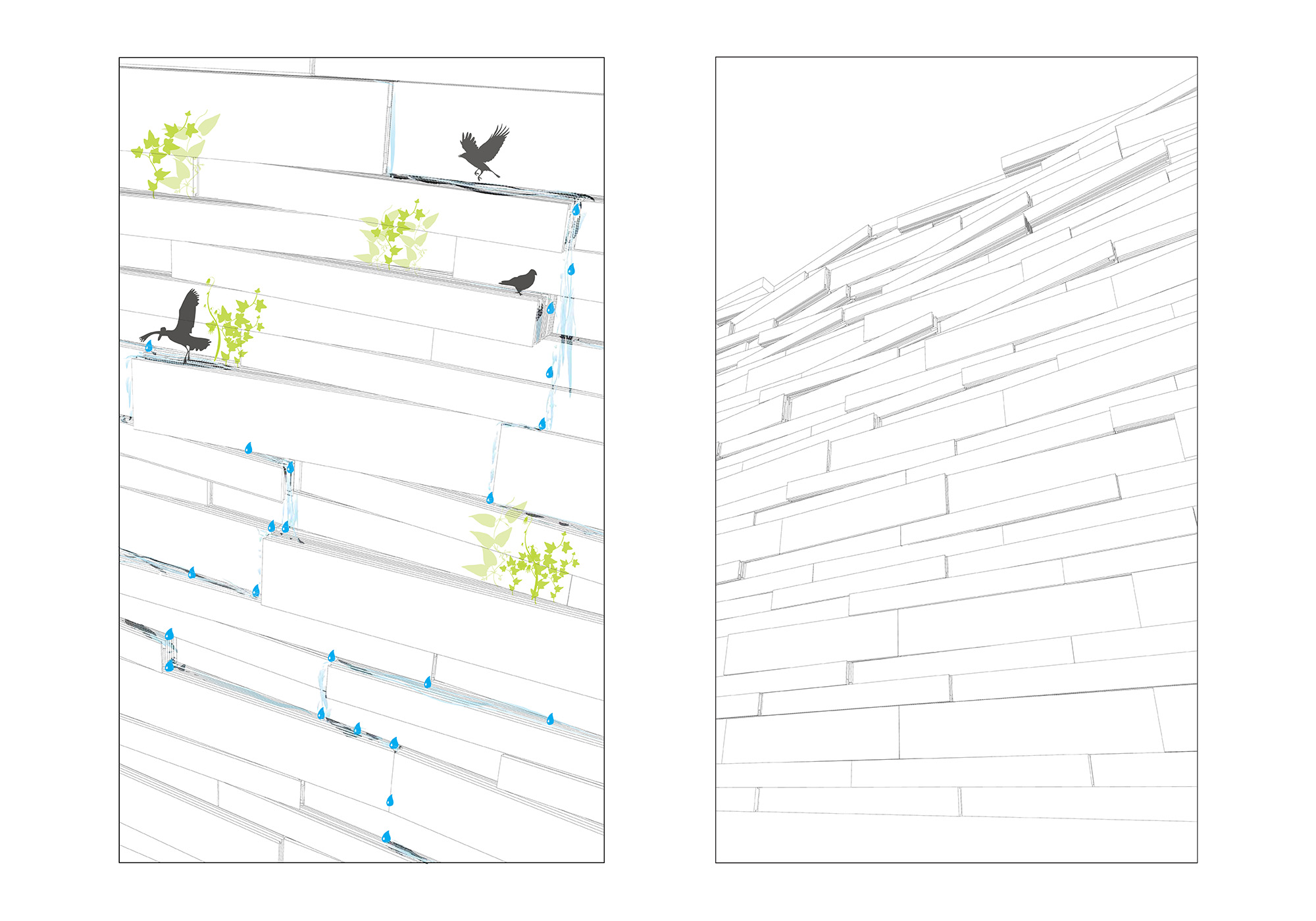
CD: Today’s trend is towards architectural and urban revegetation. Nature colonises roofs, façades… every call for projects implies the implantation of biodiversity. How can we explain all these convergences of interests regarding urban biodiversity?
AH: In fact, the interest of urban biodiversity is twofold: on the one hand, it concerns biodiversity itself, and on the other, the city-dwellers. Ordinary nature is disappearing from today’s city when it was still present yesterday. A few decades back, Paris used to be surrounded by fallow lands and small agricultural plots. Nowadays, we are separated from the first ‘little natural spots’ by industrial areas, motorway junctions, sterile agricultural plains… Yet, we all wish to be able to gaze at birds, to show them to our children otherwise than on a T.V screen, and to appropriate them: ‘this is my butterfly’, ‘here’s my robin’ (the one I see every day)… Being able to watch nature from home and in familiar places ends up generating vocations: we love and protect what we know. To a city-dweller, this represents the opportunity to witness life’s evolution, to watch seasons unfold…
CD: This is regarding the city-dweller, but what about biodiversity?
AH: Working in the city brings not to consider the urban environment as sterile, by setting up links, environmental continuities. There are generally more native species in an urban environment than, for example, in a fenceless great intensive-agriculture plain, which creates biological and vegetal deserts. Conversely, there are more than a hundred different bird species within Paris thanks to the old parks : le Père-Lachaise, les Buttes-Chaumont… a full range of urban biodiversity, also to be found in/on the buildings. Swiss studies made it possible to inventory up to 300 beetle species on the buildings’ green roofs. We build here and we live here. The projects are made here: let’s take the means where they are, and let’s take part in ordinary nature’s conservation before it disappears.
For about forty years I have witnessed a degradation, a depletion, a normalisation of common diversity: this is equally due to the public development policies as to the individual behaviours, by lack of culture and interest… But today, the global perception has changed. We have gone from protecting ourselves from nature, to protecting nature from ourselves. And there is plenty to do. The time and resilience scales we are dealing with are not those of overall problems such as the global warming: each small action can lead very quickly to concrete results. As soon as next spring, the children in Boulogne will see titmice nest into the walls of their school.
